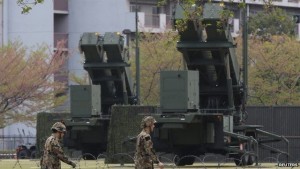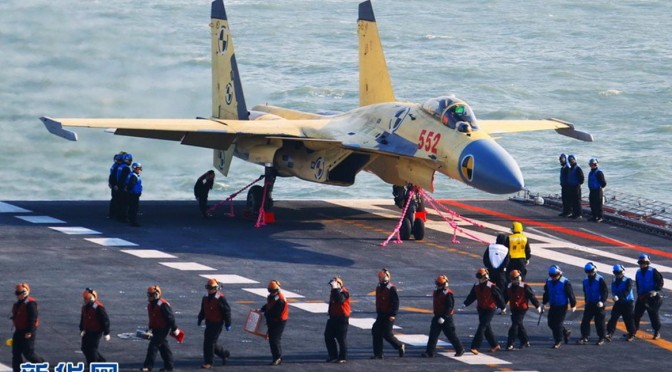Welcome to part one of the January 2016 members’ round-up! Over the past month CIMSEC members have examined several international maritime security issues, including future development programs for the U.S. Navy, Japanese naval strategy in the Asia-Pacific, North Korea’s nuclear weapons test, legal discussions over the U.S. South China Sea Freedom of Navigation Operations (FONOP) and China’s aircraft carrier procurement challenges.
Beginning the round-up at the Center for Strategic and Budgetary Assessments, Bryan Clark discusses the new Chief of Naval Operation’s vision for the future of the U.S. Navy. Mr. Clark explains that adaptability is a critical factor that the Navy must retain in order to effectively navigate the complex issues the force will see in the future maritime environment. Further to this, he elaborates on the potential challenges the Navy will face implementing an adaptability design as the Navy’s organization, training and equipping functions historically have not been developed for such fluid flexibility. Also discussing the CNO’s new design for the Navy, Chuck Hill for his Coast Guard Blog highlights the key developments raised within the CNO’s “Maintaining Maritime Superiority” document, including the changing dynamics of the global maritime environment and the recognition of increased competition U.S. naval forces are facing in the maritime domain from Russia and China.
[otw_shortcode_button href=”https://cimsec.org/buying-cimsec-war-bonds/18115″ size=”medium” icon_position=”right” shape=”round” color_class=”otw-blue”]Donate to CIMSEC![/otw_shortcode_button]
Sam LaGrone, at U.S. Naval Institute News, discusses the future surface combatant study taking place this upcoming summer. Mr. LaGrone explains that the study intends to comprehensively identify the capabilities that will need to be acquired by the Navy to effectively manage the threats the surface fleet will face in the future. Additionally, Mr. LaGrone highlights the strategic and fiscal importance of the future surface fleet having substantial multi-mission capability and an ability to remain relevant through technological advancements in weapon and sensor systems by ensuring the fleet is capable of handling frequent upgrades.
Bryan McGrath, for Information Dissemination, analyzes the ongoing debate concerning the procurement of the Ford-class aircraft carriers and more generally, the strategic benefits the aircraft carrier brings as a key component of the Navy’s force structure. Mr. McGrath outlines five underlying features surrounding the current debate, including the immediate costs of procuring large high-end carriers and the necessity for the air-wing to evolve to provide long-range stealth-strike capabilities, sea control, organic refueling and intelligence, surveillance and reconnaissance (ISR) operations.
Entering the Asia-Pacific, Harry Kazianis for The National Interest examines Japan’s strategy to develop an anti-access/ area-denial (A2/AD) capability to restrain Chinese naval and air operations in the region. Mr. Kazianis explains that a primary component of this strategy is the placement of anti-ship and anti-aircraft missile batteries along 200 islands in the East China Sea stretching 870 miles from mainland Japan towards Taiwanese territory.

Mira Rapp-Hooper at Lawfare provides a breakdown of Defense Secretary Ash Carter’s detailed explanation of the USS Lassen’s South China Sea FONOP. Ms. Rapp-Hooper explains how Carter’s letter clarifies that freedom of navigation operations are merely intended to challenge excessive maritime and territorial claims according to international law and not to affirm support for any country involved in the dispute. She also outlines the letter’s second key assertion, which states that the USS Lassen operation in the South China Sea was consistent with the principle of ‘innocent passage’, suggesting that the operation consisted of no illegal activities or actions.
To conclude this edition of the member’s round-up, James Goldrick at The Interpreter discusses recent developments in China’s aircraft carrier program and outlines the PLA-N’s intentions for at least four carrier battle groups to be introduced as a means to support Chinese maritime and security interests in the region. Mr. Goldrick explains that for China’s carrier program to yield successful results, the volume of indigenous Chinese expert shipbuilders needs to substantially increase to meet the design and concept demands their high-end naval programs are requiring – including the PLA-N’s conventional and nuclear submarine development programs.
Members at CIMSEC were also active elsewhere during the first part of January:
- Eric Hahn, for Blue-Value Facilities Engineering, explains the importance and strategic value of superior simulation and modeling concerning the development of the U.S. Navy’s future ‘adaptable’ fleet. He adds that using modeling and simulation can contribute to effective design development, which can ultimately reduce costs and delays of weapon system procurements and increase operational availability.
- Kyle Mizokami, for Popular Mechanics, examines the features of the U.S. Air Force’s new delivery system for a tactical nuclear weapon – the B61-12. Mr. Mizokami explains that the weapon system has standoff capabilities, a low explosive yield and is extremely accurate from afar, which has contributed to critics arguing this precise low-yield nuclear weapon has the potential to be ‘talked into use’ and severely increases the threat of nuclear confrontation.
- Scott Cheney-Peters, for The War on the Rocks, provides a novel review for fellow CIMSEC member Claude Berube’s new book, Syren’s Song: A Connor Stark Novel. Cheney-Peters outlines parallels between naval operations in the novel and the real-world implications of such strategies and weapon systems.
- Paul Pryce, at Offiziere, discusses the rise of the light attack fighter as an alternative air combat system to the high-maintenance and expensive fourth and fifth-generation jet fighters typically used to modernize a country’s air force capabilities. Mr. Pryce highlights the Russian Yak-130, the Chinese JF-17 Thunder and the U.S. Textron Scorpion as examples of inexpensive planes being introduced as alternative fighter or ISR aircraft throughout the world – including, the Philippines, Bangladesh, Belarus and Algeria.
- Ankit Panda, for The Diplomat, explains the circumstances that led to the Iranian Navy capturing ten U.S. sailors in the Persian Gulf and highlights the initial search and rescue response taken by the Harry S. Truman Strike Group after communications were lost. Mr. Panda shares another article at The Diplomat examining North Korea’s progress on submarine-launched ballistic missiles and explains the evidence demonstrating the SLBM tests released on video were likely altered and falsified.
- Dave Majumdar, for The National Interest, discusses Vietnam’s negotiations with American and European manufacturers to purchase advanced fighters, patrol aircraft and unmanned systems to reduce its dependency on Russia for military hardware while also increasing its capabilities to counter China’s growing power.
At CIMSEC we encourage members to continue writing, either here on the CIMSEC site or through other means. You can assist us by emailing your works to dmp@cimsec.org.
Sam Cohen is currently studying Honors Specialization Political Science at Western University in Canada. His interests are in the fields of strategic studies and defense policy and management.
[otw_shortcode_button href=”https://cimsec.org/buying-cimsec-war-bonds/18115″ size=”medium” icon_position=”right” shape=”round” color_class=”otw-blue”]Donate to CIMSEC![/otw_shortcode_button]

